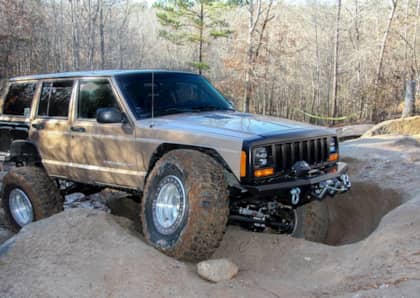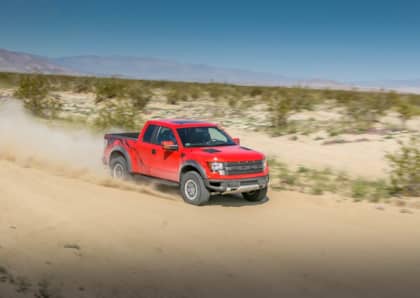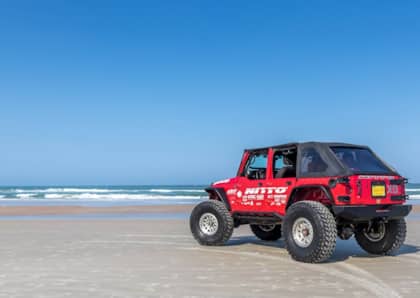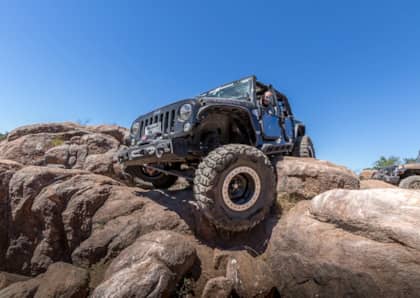Cherokee Control: Rough Country’s 4.5 Long Arm Suspension Review
When it comes to buying a pre-owned SUV that’s affordable and off-road capable, there are few better than the Jeep Cherokee XJ. While 2001 marks the last year of the classic Unitbody SUV, enthusiasts continue to embrace the platform in today. With so much aftermarket support, and a very low cost of entry, the XJ continues to be a fan favorite for those looking for a four-door Jeep, but don't want to pay for the premium price that a late-model Wrangler Unlimited JK demands.
Recently, our friend picked up a 2001 XJ with the intention of making it a fun weekend ‘wheeler and family adventure vehicle. Out of the gate, he knew he wanted to run a 33-inch-tall tire as he was happy with that size and performance on a previous XJ build. Not wanting to trim the wheelwells out extensively or lift it an extraordinary amount, he opted to meet in the middle with 4.5 inches of lift. Since the XJ’s stock control-arm angles get a little extreme over 3 inches of lift, he decided to jump directly to a long-arm kit from Rough Country Suspension.
While Rough Country offers a few suspension systems for the XJ platform, the company’s 4.5-inch long-arm is ideally suited for those looking for better on- and off-road handling. To check out our friends build, we stopped by his garage as he was just getting a move on the lift. Of course, we documented the process in the video above, and now, we’re diving deeper into the details in the article below.

From the factory, Jeep fit the Jeep Cherokee XJ with a multilink front suspension. The stock setup uses four control arms and a track bar to isolate the axle. While this works excellent in stock form, raising the Jeep increases the angles of the control arms. This increased angle often results in poor handling on-road and less-than-stellar performance in the dirt. Moving to a long-arm suspension effectively doubles the length of the arm, thus decreasing the operating angle. The result is a better ride and handling characteristics on-road and off.

Moving to a longer control arm requires new mounting points for the arms to attach. Rough Country provides a new crossmember that bolts in place of the stock unit. Attached to it are side-mounted brace plates per side. Also included is a transfer case skidplate. Though the new crossmember and braces require a few holes drilled, the sheetmetal Unitbody structure doesn’t put up much of a fight against a new drill bit.

To make room for the new control arms, you’ll need to remove the stock lower control arm mounts from the Jeep. We’ve found that a Sawzall works excellent at getting the bulk of the bracket out of the way.

Rough Country uses a radius style control arm to secure the axle. Both the upper and lower arms are fully adjustable. The upper comes with Rough Country’s flex joint, while the lower uses a flex joint at the crossmember and OEM-style Clevite rubber bushing at the axle.

Raising the front of the Jeep are 4.5-inch lift coils, which are paired with Rough Country’s Performance 2.2 Performance Series shocks. Also included are new stainless steel braided brake lines. Note, the stock bumpstop had disintegrated from age. A replacement set was order post lift.

Keeping the front end geometry in check is a new track bar bracket that converts from single to a stronger double-sheer setup. A drop pitman arm is used to keep the mounting points in sync.

Another handy feature for those who off-road on the regular are the included sway-bar disconnects. These quick-release links come with a lanyard that’s mounted to the XJ via self-tapping screws. This creates a safe and secure place to attach the sway bar when you’re hitting the trail.

Rough Country offers a few options to raise the rear of the Jeep, but for this particular build, the full replacement spring packs were used. The new leaf-springs include axle-specific U-bolts, and like the front, you’ll get a set of Performance 2.2 shocks.

One option we covered in the video was the slip-yoke eliminator kit. By replacing the slip-yoke output on the back of the NP231 transfer case with a SYE conversion from Rough Country, you’re able to fit the XJ with a 1310 double-cardan rear driveshaft, which is necessary to prevent driveline vibrations. This setup moves the slip-portion of the ‘shaft into the new driveshaft. This is a safer and stronger setup over stock.

After getting the Jeep on its wheels, the steering linkage is hooked up along with the new adjustable track bar. Once the new Rough Country steering stabilizer was installed, a quick trip to the alignment shop ensured the XJ was tracking straight.

This Jeep is running a set of 33x12.50R15 Nitto Trail Grapplers, which is a great balance for the road and trails it will see in the Southeast. The meaty mud-terrain radial required trimming of the front bumper and along the back of the flare. Since the Jeep was still missing the front bumpstops when we shot it, the tire popped off the front flares a time or two. New bumpstops and a little more trimming should take care of any additional rubbing issues.

The new treads were secured on by 15x8 Ion Alloy 174 wheels. This aluminum wheel set provided a good balance of backspacing, which can be critical when attempting to cycle the tire without contacting the body or suspension components.

Despite the longer control arms, very little ground clearance was sacrificed. If the Jeep does happen to make contact with the trail, we’re sure the 0.250-wall control arms can take the abuse.

We got to spend a little time with the XJ in the dirt and were impressed with how stable it felt. With the sway bar disconnected, the suspension worked well to keep the Trail Grapplers planted. Sure, a set of differential lockers would help add to the off-road prowess, but for now, the build is off to a great start.

This is by no means the stopping point for this build. Now that it has a proper set of treads and trail-worthy suspension, the focus can be shifted to more items that will make it tackle the trail even better.












